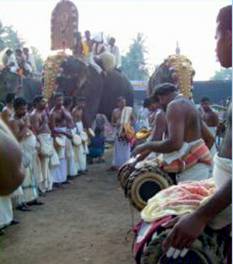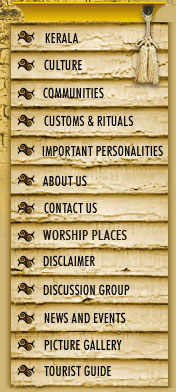|
Sabarimala Vruthanushtanam
Sabarimala
is a famous pilgrim centre. Lord Ayyappa otherwise known as
‘Kaliyuga Varadan’ is the chief deity of Sabarimala. It was
considered as a holy act observe vrutha and to undertake Sabarimala
pilgrimage. Those who observe such vruthas were called
‘Ayyappan’. Women were not allowed to undertake Sabarimala
pilgrimage or to mount Sabarimala.
Sadya

The grand feast organised in connection with celebrations, festivals, marriages and other auspicious functions.
Sakunam (omens)
The
belief that the omens that we see at the time of starting a journey
influence its result was in force from the very early period
itself. Certain things were considered as bad and certain others
good. This is known as Sakunam Nokkal. There are good and bad Sakunams. If we see bad Sakunam we have to return back to the starting place, sit a while and
continue the journey. Seeing a single Brahmin while commencing the
journey is a bad omen, whereas two Brahmins is good. The
things of omen are classified as follows in the Malabar Manual
Good Omens:
Curd, raw rice, honey, ghee of cow, lead, sulphur, metal filter,
sound of bell, vilakku (lamp), lotus, karuka grass, raw fish, meat,
grain powder, ripe furits, sweets.
Bad Omens:
A handicapped person or blind, widow, salt, donkey, pieces of rope,
broken vessels, screaming sounds, deep yelling, sneezing, cursing and
sudden shivering and falling.
A
crow flying left or rightwards is a good omen. A black cat
running or jumping across is bad. Flowers and bangles are good
omens. A cow with rope is also a good omen.
Samaavarthanam
Samavarthanam is one of the Shodashacharangal of Namboothiris. Samaavarthanam is the occasion of the boy's return to normal life after education. It is performed after the age of 14 years
Sambhandham
When
Brahmins became the masters of temples, their political influence
also strengthened. Gradually they became landlords. To
maintain their property in tact and to avoid its division, they
practiced the theory that the eldest of their son alone will marry
from the same caste and others from Nair classes. The practice of marrying nair girls by younger brothers of a brahmin family is
known as Sambandham. Though Brahmins considered Sambandham as one of the 64 Anacharams (social do-nots), this type of alliance existed for centuries. Gradually Sambandham became
common within Nair community also. However, the matrimonial alliance
of females was not so rigid. Those who came into union with
Brahmins maintained their moral values and kept their standards.
The legal validity for Sambandham marriage came to an end with the enactment of the Nair Regulation Act
of M.E.1100 (1924 A.D.). The new regulation prohibited them
to own and disown wives at their pleasure. Certain conditions were
also laid out for divorce etc.
“Sambandham means simple nair marriage ceremony involving presentation of a cloth
by a man to woman. In ancient Kerala it appears that both men and
women could have Sambhandam with more than one person at the
same time. Marriages contracted and ended with considerable
ease. This was called Sambandham and a woman might have Sambandham with a number of men at the same time. Either man or woman could end the Sambandham with little formality” (Robin Jeffri, The Decline of Nayar Dominance).
“In
a Namboothiri family, only the oldest brother was allowed to marry;
he could marry up to four Namboothiri women. The younger brothers were
allowed to enter into relationships with Nair women. The Nair woman
would then have two husbands (a Nair and a Namboothiri) and in
essence, a system of polyandry came into being. However, as a
consequence of this practice, the number of Namboothiris declined and
the number of Nairs increased because the children born in a
Nair-Namboothiri marriage would belong to the Nair woman's family. The Sambandham practice was marginal and existed only for a short period of time. It does not exist today”. (Wickiepepdia)
Sambandham relates
to Nair marriage. It is known so in South Malabar, Kozhikode,
Ponnani, Kochi and in some parts of Travancore. The Sanskit
words like Sambandham and Bandhavam came to common use after the Aryan domination. In earlier days marriage denoted the grand function organised on the eve of Thalikettu. The marriage among Nairs was usually called as Pudavakoda, Pudakamuri, Uzham Porukkal etc. Sambandham was known as Pudamuri, Uzhamporukkuka and Vidaram Kayaruka in North Malabar; Gunadhoshm in South Malabar and Kidakka Kalyanam in certain areas of Palakkad. The functions related to this were very
simple. The bridegroom arrives in the bride’s residence on the
appointed day and time along with his near relatives. The bride’s
brother will wash the feet of the bridegroom and then he enters the padinjatta (main room of the house) and gave four or eight cloths, betel wine
and areca nut to the bride. After food, the bride’s aunt leads the
groom and bride to the Maniyara (room for the married
couple). The groom will leave to his residence the next day or
after one or two days. When he comes with his friends for the
second time, the bride also will be taken to the groom’s residence
either by himself or by the women of his family. It is interesting to
note that the functions like Thalikettu (tying thali-gold ornament around bride’s neck) Mothiram aniyal (exchange of rings) and garlanding were not there in Pudavakoda. Those attending the functions will be less than twenty. The person who gave the pudava was known as Gunadoshakkaran.
The Pudamuri of
North Malabrar was celebrated in a grand manner. After
comparing the horoscopes and fixing a date the bridegroom and his
relatives and friends proceed to bride’s residence after sun set.
The bride’s relatives will arrange a reception to the party.
After feast, the astrologer declares the auspicious time for Pudamuri. Then the groom will be taken to padinjatta (the main room of house). Nilavilakku, Ashtamangalyam,
paddy tender leaf of coconut, bow, mirror etc will be placed in the
room. The bride who is well adorned with various types of
ornaments will be led to this room. The bridegroom will give pudava (new cloth) to the bride who is facing to the eastern direction. The functions of pudamuri will
end for that day. Next day the grooms relative will take the
bride to grooms house after attending the function known as ‘vettilakettu’.
Uzham Porukku and Vidaram Kayaral were the special type of marriages in North Malabar. Pudamuri was
an expensive affair and therefore all cannot afford this.
Therefore, some depend on Uzham Porukku. The functions were same as that of pudamuri but they were less expensive and conducted in a small scale.
Giving way of pudava was not done in the Sambandham of South Malabar and Kidakka Kalyanam of Palakkad. Instead of Pudava, cash
will be given. The bride will not be taken to the
bridegroom’s residence. Therefore, there will not be any
reception.
Sayanapradikshnam
Sayanapradikshnam is an offering in temples for the relief from illness as well as for
fulfillment of desired aspirations. After lying on the floor of
the temple in a praying mood one has to roll round the temple through the pradishkshna (round) way. Usually three or more round are taken.
Seemantham
Seemantham is one of the Shodashacharangal of Namboothiris. Seemantham is a pre-delivery ritual to be performed in the 4th month of pregnancy, but after Pumsavanam,
for the health of baby and to make the delivery smooth and safe. The
husband combs the hair of pregnant wife from backwards to front using a
small twig, thorn of a pangolin and dharbha grass, is one of the functions connected with the ritual.
Seeveli

The practice of taking the idol of Gods to outside the sanctum sanctorum every day is known as Seeveli. There are different types of seevelis like Ethritha Seeveli, Uccha Seeveli and Athazha Seeveli. It was Sreebhoothabali that was converted as Seeveli.
Sekom
Sekom
is one of the Shodashacharangal of namboothiris. Sekom is the
consummation of the marriage. It is a rite supported by Vedic chanting
to be performed just before they start their wedded life and first
sexual intercourse in the first night. In olden days the
marriage process lasts for 4 days and ends with Sekom and the
bridegroom and bride meet each other only on the 4th day.
Shodashacharangal
Shodashacharangal is the sixteen rites to be performed by the male members of Namboothiri community. Without performing the shodashacharangal a
Namboothiri will not become a real Brahmin. Female members of the
community are also expected to follow certain among these rites. The
sixteen rites are: (1) Sekom, (2) Pumsavanam, (3) Seemantham, (4)
Vishnubali, (5) Jathakarma,(6) Namakarana, (7) Nishkramanom, (8)
Annaprasanam, (9) Choulam, (10)Karnavedham, (11) Upanayanam, (12)
Vedarambhom, (13) Kesantham, (14) Samavarthanam, (15) Vivaham, and
(16) Adhanam.
Somavaravrutham
The vrutha (penance) observed on Monday is known as Somavaravrutham.
It is beneficial for married life. Prayer at Siva temple has to
be done in the morning. Fasting is to be performed in
daytime. During dusk, temple visit is a must. Somam is
equal to “Sa + Uma” meaning to worship God with Uma (Parvathy). It is
believed that Parvathy observed Somavaravrutham to get Lord Siva as
her husband. |



